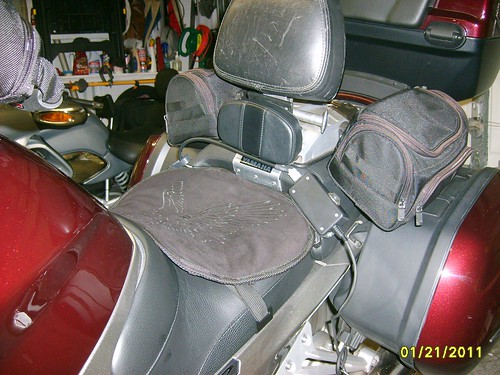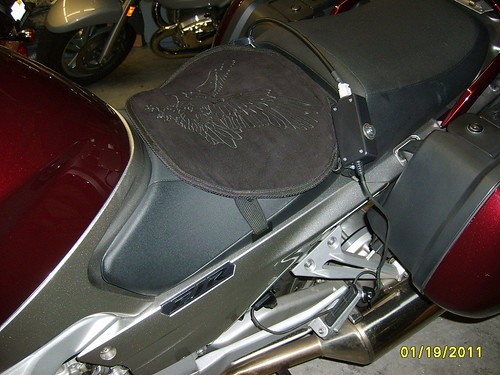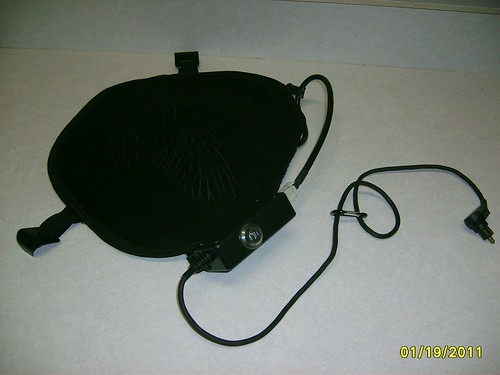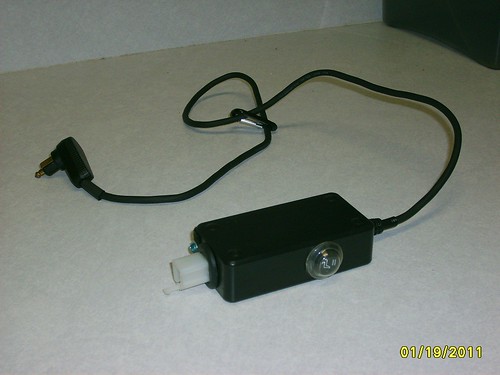Link to all my Gen II mods
This farkle makes riding year-round bearable for me. My accessory choice might have been different if I lived up north somewhere or spent more time riding in cold weather.
I mainly chose this method because I already had one of those strap-on gel pads to supplement my seats for years now and it seemed like an easy project to install a 12V heating element in it. It undoubtedly saved a few bucks over buying heated seats for the different bikes or a pricey set of heated gear. It avoids having wires to unplug every time I get off the bike. Doing this allows me to use it on any of my current (or future) bikes with a 12V Powerlet socket.
Once again, I doubt this is a good solution for the avid cold weather riders out there. But for me, it makes sense.
Here are some views of the complete set-up:



I wanted the control switch within easy reach so some Velcro attaches the box to the rear corner of the pad. The power cord runs down to the Powerlet outlet by the seat key lock and I have a clip attaching it to the passenger foot peg (Bungee Cord Anchors) so there isn’t a chance of it reaching the muffler or get pulled into the wheel well. I left the cord long so it would reach the 12V outlets on the other bikes. On the FJR, the heater is plugged into an outlet that is powered up only with the headlight on (engine running) so I don’t drain my battery by mistake when parked.
This is the kit I started with: Heated Seat Kit or here Heated Seat Kit
Out of the box, the kit can’t be considered a “portable” solution, so I had to make a little control box to house the High/Off/Low switch, fuse, and PC board. A 1x2x4” project box from Radio Shack worked nicely. It was a tight squeeze inside the box, but everything fit, including a spare 7.5A fuse. During modification of the heat kit, I made sure to keep a connector between the seat pad and control box so the box and power cable can be detached from the seat pad for summertime use.

On the road:
I took it on a 250 mile ride as the trial run and I was somewhat impressed with what a difference it makes. Temp was 46F when I left the house and I never saw higher than 57F the rest of the day. I found the high heat setting a bit too much for these temps, but that makes me hopeful this solution will be okay down in the 30/40 range. The low setting was the best choice for weather like what I saw that day. I was able to use the rocker switch with gloved hand and still feel the “clicks” between positions, although my gloves are relatively thin compared to some that I have seen.
The heat element is fair long and is intended to be cut if needed for the application. I ended up wrapping around gel insert in my seat, totally covering it on the top and bottom. If the high tends to be too hot to ever get used, I may consider cut the element off for less coverage. This will also drop the wattage requirements. Speaking of power, I saw an approximate .4V drop on the voltmeter when I switched the heat on. The battery seemed to be charging fine with the seat and grip warmers running (along with GPS and Aux lights).
What makes a gel seat less desirable in the hot summer months (retains the heat), makes it beneficial in the winter weather. That mass of gel tends to stay warm for quite a while after the heat is switched off so I found myself switching it on for 10mins then off for 20mins, as the day warmed up. Infinite heat adjustment would definitely be better, but having two heat settings is adequate, although it takes more “maintenance” to stay comfortable.
Everything considered, I think this is a viable solution for those riders in the southern states that desire to ride year round. It takes the edge off those cold mornings, and you don’t have to invest the extra money in integrated heated seats on every bike you purchase as time goes on.
This farkle makes riding year-round bearable for me. My accessory choice might have been different if I lived up north somewhere or spent more time riding in cold weather.
I mainly chose this method because I already had one of those strap-on gel pads to supplement my seats for years now and it seemed like an easy project to install a 12V heating element in it. It undoubtedly saved a few bucks over buying heated seats for the different bikes or a pricey set of heated gear. It avoids having wires to unplug every time I get off the bike. Doing this allows me to use it on any of my current (or future) bikes with a 12V Powerlet socket.
Once again, I doubt this is a good solution for the avid cold weather riders out there. But for me, it makes sense.
Here are some views of the complete set-up:



I wanted the control switch within easy reach so some Velcro attaches the box to the rear corner of the pad. The power cord runs down to the Powerlet outlet by the seat key lock and I have a clip attaching it to the passenger foot peg (Bungee Cord Anchors) so there isn’t a chance of it reaching the muffler or get pulled into the wheel well. I left the cord long so it would reach the 12V outlets on the other bikes. On the FJR, the heater is plugged into an outlet that is powered up only with the headlight on (engine running) so I don’t drain my battery by mistake when parked.
This is the kit I started with: Heated Seat Kit or here Heated Seat Kit
Out of the box, the kit can’t be considered a “portable” solution, so I had to make a little control box to house the High/Off/Low switch, fuse, and PC board. A 1x2x4” project box from Radio Shack worked nicely. It was a tight squeeze inside the box, but everything fit, including a spare 7.5A fuse. During modification of the heat kit, I made sure to keep a connector between the seat pad and control box so the box and power cable can be detached from the seat pad for summertime use.

On the road:
I took it on a 250 mile ride as the trial run and I was somewhat impressed with what a difference it makes. Temp was 46F when I left the house and I never saw higher than 57F the rest of the day. I found the high heat setting a bit too much for these temps, but that makes me hopeful this solution will be okay down in the 30/40 range. The low setting was the best choice for weather like what I saw that day. I was able to use the rocker switch with gloved hand and still feel the “clicks” between positions, although my gloves are relatively thin compared to some that I have seen.
The heat element is fair long and is intended to be cut if needed for the application. I ended up wrapping around gel insert in my seat, totally covering it on the top and bottom. If the high tends to be too hot to ever get used, I may consider cut the element off for less coverage. This will also drop the wattage requirements. Speaking of power, I saw an approximate .4V drop on the voltmeter when I switched the heat on. The battery seemed to be charging fine with the seat and grip warmers running (along with GPS and Aux lights).
What makes a gel seat less desirable in the hot summer months (retains the heat), makes it beneficial in the winter weather. That mass of gel tends to stay warm for quite a while after the heat is switched off so I found myself switching it on for 10mins then off for 20mins, as the day warmed up. Infinite heat adjustment would definitely be better, but having two heat settings is adequate, although it takes more “maintenance” to stay comfortable.
Everything considered, I think this is a viable solution for those riders in the southern states that desire to ride year round. It takes the edge off those cold mornings, and you don’t have to invest the extra money in integrated heated seats on every bike you purchase as time goes on.
Last edited by a moderator:



